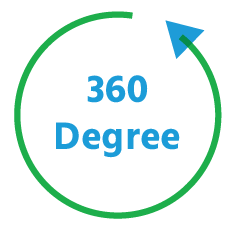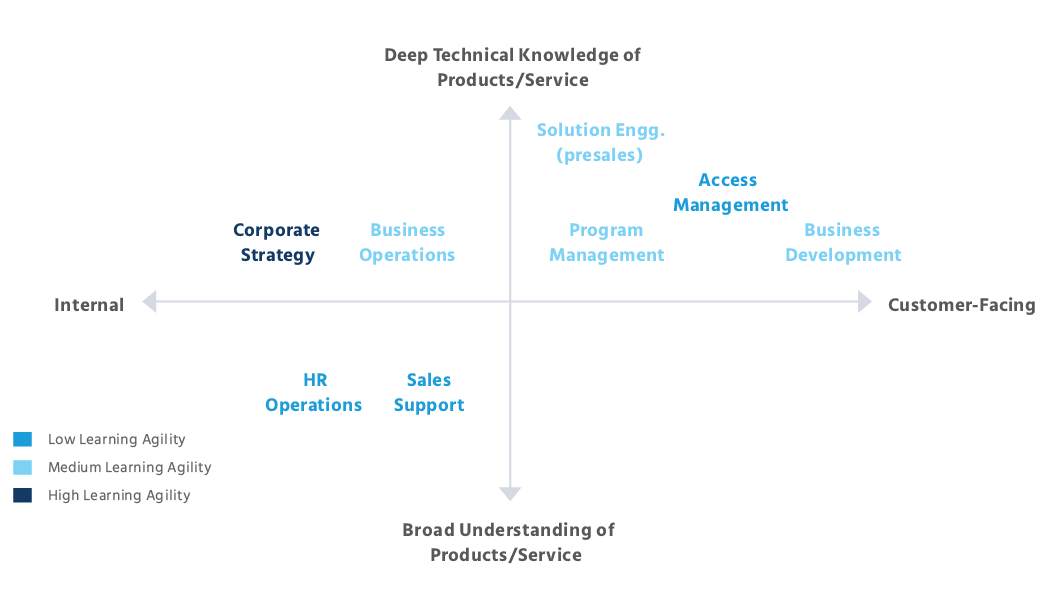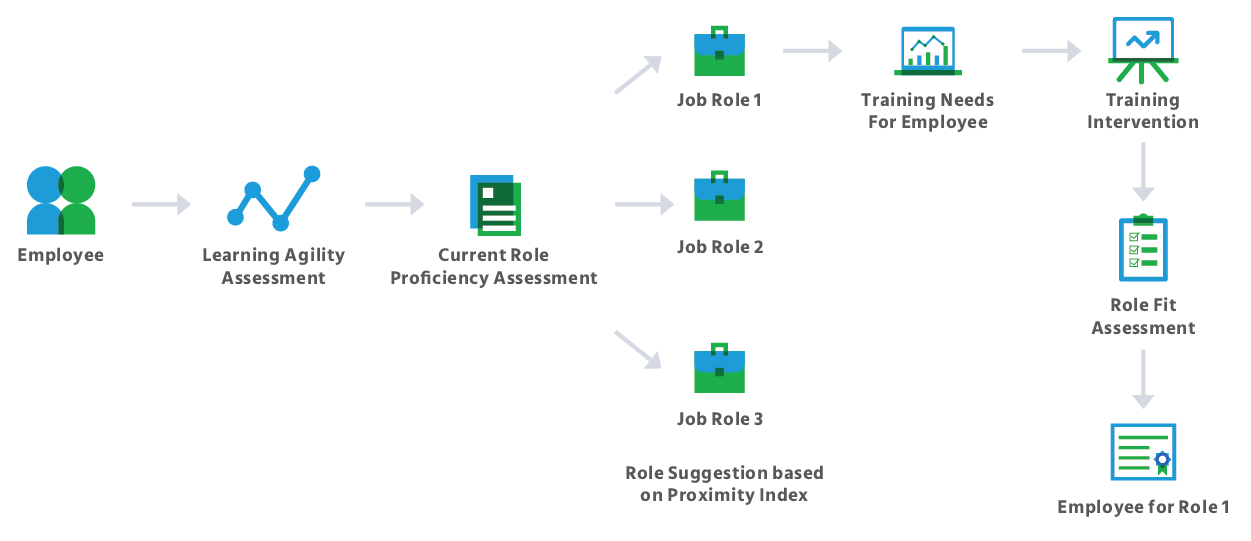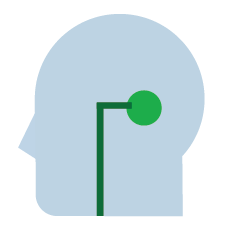Step 1-
Competency Framework for Each Job Role
In today’s dynamic business environment, most organizations prefer to train their existing resource over hiring a new candidate. The expenditure is huge in recruiting the new workforce. Effective training and development programs help you in understanding the present and future competency requirements of individuals. As the skills lagging can be improved upon by the supervisors or trainers. You can follow this process and make a list of competencies that need supervision and can prepare the employee for future tasks and responsibilities.
You can take into account the following elements to develop a Training and Development program. It accurately identifies the training needs of your workforce, making them future-ready.
- Job roles that would stay the same
- Job roles that would transform in the future
- Job roles that are expected to become obsolete
- New job positions that would be introduced in future
You can then assess each job role in detail and analyze the difference between the present and future competency framework to identify the job roles that are most likely to have the highest skill gaps.


How Mercer | Mettl Can Help?
Mettl Redundancy Index helps you in assessing job roles that are expected to become redundant with the introduction of Artificial Intelligence, advanced technologies, and automation. The index explains which skills would be obsolete in the near future.
Based on the index analysis, Learning and Development managers can identify the job roles and skills that require focus while undertaking Training and Development programs. The Mettl Redundancy Index also helps in deprioritizing skills that will be irrelevant in the future.
Mettl helps organizations create Competency Frameworks that play a crucial role in crafting well-designed training and development programs for each job role. It helps employers in knowing the skill-sets required by each employee in performing the job smoothly and effectively.
Step 2-
Training Needs Analysis
The next step in the Training and Development plan is to understand the training needs of the employees. You can identify the training needs of employees by determining the skill set possessed by the employee currently and the skills required by each employee to perform the job. The competency framework helps in determining the latter. In addition, it also helps in understanding if an employee in any job role is adequately skilled, over-skilled or under-skilled.
Some employees may not require any training, and hence, considerable time can be saved by not imparting training to skilled employees.
In a nutshell, you need to evaluate the workforce against the applicant’s job roles’ competency framework regularly. The objective is to identify the skill gaps and training needs in each employee accurately.
Assessment Tools Required to Identify the Skills Gap
- 360-degree feedback
- Assessment centers – Virtual Assessment/Development Centers
- Learning Agility
- Proximity Index
 360-Degree Feedback
360-Degree Feedback
It is a modern method of performance appraisal to determine an employee’s performance at his/ her workplace.
The feedback assessment tool enables employees to improve their skill gaps based on the suggestions and feedback received from their supervisors, subordinates, and peers. It presents a clear picture of the employee’s performance, skills, and behavior, along with the organizational environment.
The performance appraisal system allows the organization to adapt and remain flexible, depending on its workforce’s needs. The opinions and views are typically obtained from superiors, peers, subordinates, or customers. Once the performance appraisal feedback is obtained and analyzed, it is shared with the employees to further their personal development goals.
 Assessment Centers (AC) – Virtual Assessment/Development Centers(VC/DC)
Assessment Centers (AC) – Virtual Assessment/Development Centers(VC/DC)
These centers evaluate employee competencies and behaviors based on task-based exercises and multiple evaluations such as interviews, job-related simulations, etc. It is one of the effective ways to identify training needs. They are hassle-free, virtual, and convenient .There is no need for a particular setup, other than computers and internet connectivity. You can modify the content of the assessments based on the organization’s target audience,competency framework and the context. Besides that, it is cost-effective and provides automatic results of assessments.
VAC is a complete online suite of scientifically validated tools and assessments provided by companies such as Mercer | Mettl. It helps in the professional development of employees based on the competencies expected from a concerned role. It provides a detailed report by assessing you on various aspects and evaluating your current proficiency.
The measurement process considers:
- Cognitive ability
- Personality traits
- Demonstrated behaviors
- Functional knowledge/skills
How Mercer | Mettl Can Help?
Mercer | Mettl helps in discovering training needs in employees via various tools such as Training Needs Identification assessments, Assessment & Development Centers, and 360 Feedback.

 Learning Agility
Learning Agility
Identifying the development areas in each employee is not sufficient to create Training and Development programs. As a Training and Development Manager, you should be aware of the capability of each employee to be trained on particular skills. You can consider the employee’s existing skill proficiency levels and learning agility.
Learning Agility refers to the ability of the person to understand and learn new skills and competencies under the same umbrella.
It helps employers in understanding the degree of training of their employees. The employee may have significant skill gaps, but if that individual does not possess the required skills and knowledge, optimal results cannot be obtained merely by imparting the training. Therefore, organizations measure employee learning agility to gauge employees’ capability of upskilling.
Mettl has a method in place to measure a person’s Learning Agility based on two factors: readiness and orientation.
The Readiness to Learn:
This aspect evaluates a person’s capability to learn things quickly by identifying logical rules, patterns, and trends in the new data.
The Orientation to Learning:
This aspect measures a candidate’s ability to seek new learnings from training quickly and executing challenging tasks efficiently and effectively.
A person’s learning agility varies from high to low. It could be low, medium or high depending on how fast the individual grasps things. It is also based on certain behavioral and cognitive competencies.
Mettl has a Learning Agility Matrix in place that measures a candidate’s individual and organizational learning agility on the learning ability levels and the intent possessed by them.

A person who has high learning intent and ability possesses high learning agility and vice versa.
 Analyzing Proximity Index
Analyzing Proximity Index
Proximity index refers to the person’s ability to learn new skills that can be mastered easily in less time. It is generally based on the candidate’s current skill sets.
For instance, individuals expert in excel can easily learn Data Sorting, and then Pivot Tables. They can be adept in Data analytics by further upskilling to Data Validation.
A proximity index analysis is necessary so that business goals and learning and development process can be aligned. Also, you can ensure highest employee engagement in the organization. You can use Proximity index analysis to differentiate the skills required for one job family that is the skills needed for other job families. Apart from that, you get to know the commonality between skills in different job families
You can determine new job roles for the employee, based on the information provided by the proximity index. Apart from that, the index acquaints you with the skills that should be learned by every employee. It helps in removing redundancy and attaining maximum efficiency within the workforce.
The table below showcases the Proximity Index chart of employees with low, medium, and high learning agility:

Mercer | Mettl helps in measuring Proximity Index by laying out a detailed process:
Conduct Job Family Analysis
Under this process, you need to select 3-4 related Job Families among your team and analyze the current job families of your team members such as Team Management/ Project Management/ Delegation/ Leadership, etc. Then you have to research the upcoming trends in areas concerning the job family and future interest areas.
A job family groups jobs by common professions or vocations. It requires similar knowledge, skills, and abilities that represent a career path from the lowest to the highest job level. For example, one job Family can be Advising/Student Services/Career that guides staff, faculty, and students. Another Job Family can be Educational/Academic Support that develops content for clients.
Map Skills and Competencies to Job Roles
The next step is to identify and map the team members’ skills and competencies to the underlying current job roles and check whether they fit for the right job role. This is how team members are introduced to new skills and competencies, and organizations can have a future-ready skilled workforce.
Develop Proximity Index for Job Families
The third step is to understand how the current skills and competencies of employees are close to the ones required in the future. The employee who has high learning agility can imbibe more knowledge and skills that are distant and fall under the same umbrella -for example, Marketing research, Data Analytics, CRM skills, etc. The existing employees with low learning agility are given the requisite training to hone their skills and competencies.
After analyzing the proximity between the current and the future skills of employees, you can create a proximity index for each current job family with the future ones. You have to then map the learning agility required in combination with Proximity Index to move across job roles.
Assessment Creation
After developing the Proximity Index for job families, employee assessments are created to ascertain the learning levels in their current job roles. It is easy for employers to align the potential employees in the required job roles. The objective of the assessment exam is to place existing and future employees at the right place and at the right time. It also helps the existing workforce to enhance their domain knowledge and current skill set.
Overview of The Proximity Index:

Step 3-
Creating an Individual Development Plan
After assessing the employee skills gap through various assessment tools, learning agility, and Proximity Index, you need to create an achievable and relevant Individual development.
An individual development plan consists of the following elements:
- Employee’s skills gap
- Employee learning agility and learning aspirations
- Employee’s present skill set and proficiency level
- Most easily trainable skills on proximity index
The individual development plan also lays out the skills required to be trained most rigorously by the employee:
- Skills that the employee wants to learn
- Skills the employee needs to learn
- Skills that the employee is capable of learning
Training of other skills should be prioritized based on the relevance of employees’ current job, career aspirations, and how easily they can be trained on the current skill set and learning agility.

Step 4-
Training Delivery
Imparting training to the unskilled employees follows the Training and Development process. This step is primarily about training your existing workforce to ensure meeting the business goals. It also ensures that the organization attains a high ROI in the training program.
You can deliver training into two parts:
- To create the right Training program
- To deliver the right Training Program









 Behavioral Competencies
Behavioral Competencies Cognitive Competencies
Cognitive Competencies Coding Competencies
Coding Competencies Domain Competencies
Domain Competencies

















 360-Degree Feedback
360-Degree Feedback Assessment Centers (AC) – Virtual Assessment/Development Centers(VC/DC)
Assessment Centers (AC) – Virtual Assessment/Development Centers(VC/DC)
 Learning Agility
Learning Agility
 Analyzing Proximity Index
Analyzing Proximity Index



 Reaction: Under this level, you measure an individual’s reaction and response to the training, the significance and the convenience of the preparation. Apart from that, you can consider questionnaires, reviews or talk to participants to gain training feedback from employees.
Reaction: Under this level, you measure an individual’s reaction and response to the training, the significance and the convenience of the preparation. Apart from that, you can consider questionnaires, reviews or talk to participants to gain training feedback from employees. Learning: This level evaluates the employee’s understanding level of the training sessions.
Learning: This level evaluates the employee’s understanding level of the training sessions. Behavior: It measures how individuals who have undergone training are making judicious use of new learning concepts and methods. You can cross-check trainees by taking 360-degree feedback from peers, supervisors, and subordinates.
Behavior: It measures how individuals who have undergone training are making judicious use of new learning concepts and methods. You can cross-check trainees by taking 360-degree feedback from peers, supervisors, and subordinates. Results: The last level focuses on the final results of training and if it has made some impact on trainee’s performance and behavior in any way. It analyzes the difference in participant’s behaviors before and after the program. Some of the possible outcomes you can expect from the trainee are listed below:
Results: The last level focuses on the final results of training and if it has made some impact on trainee’s performance and behavior in any way. It analyzes the difference in participant’s behaviors before and after the program. Some of the possible outcomes you can expect from the trainee are listed below:









Would you like to comment?